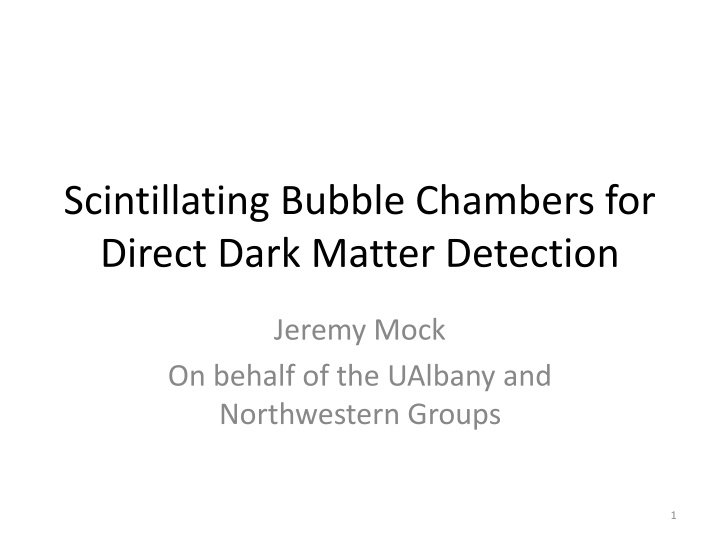
Innovative Dark Matter Detection with Scintillating Bubble Chambers
Explore the groundbreaking technology of scintillating bubble chambers for direct dark matter detection, combining the advantages of energy measurement and background rejection. Learn how these chambers work, offer superior discrimination against electromagnetic backgrounds, and enhance sensitivity to spin-dependent interactions.
Uploaded on | 1 Views
Download Presentation

Please find below an Image/Link to download the presentation.
The content on the website is provided AS IS for your information and personal use only. It may not be sold, licensed, or shared on other websites without obtaining consent from the author. If you encounter any issues during the download, it is possible that the publisher has removed the file from their server.
You are allowed to download the files provided on this website for personal or commercial use, subject to the condition that they are used lawfully. All files are the property of their respective owners.
The content on the website is provided AS IS for your information and personal use only. It may not be sold, licensed, or shared on other websites without obtaining consent from the author.
E N D
Presentation Transcript
Scintillating Bubble Chambers for Direct Dark Matter Detection Jeremy Mock On behalf of the UAlbany and Northwestern Groups 1
People Northwestern University: Eric Dahl, Jianjie Zhang, Miaotianzi Jin, and Dan Baxter University at Albany Matthew Szydagis, Sean Fallon, and Steven Young 2
Motivation Dark Matter Search experiments rely on the ability of the detector technology to discriminate between ER and NR Typical two-phase scintillation detector can measure energy deposited but has discrimination ~ 99.5% (5x10-3) Bubble chamber has 10-10 discrimination against ER, but has no measure of energy deposited Solution: Combine the technologies 3
How a bubble chamber works Metastable fluid, in liquid phase below the vapor pressure If incident particle deposits sufficient energy, bubble formed Threshold detector: Critical energy Critical stopping power Thresholds a function of temperature, pressure Thresholds applied such that detector is insensitive to ER NR events induce bubbles Target liquid is swappable Superheated liquid gas 4
Gammas and Betas 10-10 Discrimination against electrons! Dahl - March 6, 2015 5
How a noble scintillating detector works Energy deposited in 3 channels Heat, prominent with NR reduces light and charge more than ER Organic scintillators produce scintillation, but no charge No organic scintillator TPC Larger for NR Excitation Both lead to scintillation 6
Combine the two technologies Have BOTH energy reconstruction AND fantastic rejection of electromagnetic backgrounds Consider: Xenon 107 improvement in discrimination Solves the 85Kr and neutrino-electron scattering backgrounds No drift field necessary! Argon pulse shape discrimination at higher energies, can achieve low thresholds with coupling to bubble technology Fluorinated-organic scintillators More sensitive to spin-dependent interactions 7
Consider a Xenon Chamber A xenon bubble chamber was attempted successfully in the past, but was thought not to work originally, because energy lost into scintillation instead of bubbling Scintillation was initially quenched to see high energy gammas But for dark matter detection, not seeing gammas is a strength! Nuclear recoils will make bubbles without quenching additives Tracks of high energy gammas from a xenon bubble chamber with 2% ethylene, circa. 1956 Phys. Rev. Lett. 112, 241302 (2014) IONIZATION or CHARGE Phys. Rev. Lett. 112, 091303 (2014) PhysRev.102.586 LUX CDMS SCINTILLATION OR LIGHT CRESST PHONONS OR HEAT Initially, use the scintillation and heat channels for energy reconstruction and discrimination 8
IONIZATION or CHARGE Phys. Rev. Lett. 112, 241302 (2014) Phys. Rev. Lett. 112, 091303 (2014) CDMS LUX Xe bubble chamber SCINTILLATION OR LIGHT CRESST PHONONS OR HEAT But what if the ionization could be measured as well? Unprecedented attempt at capturing all 3 dimensions of discrimination. 9
Another Possible Advantage Bubble chamber turns disadvantage of Xe into an advantage: decreasing NR S1 + S2 at low energies means more energy is going into heat And heat means bubbles, in a superheated system LUX DD Dashed NEST 1.0 Dashed NEST mod Manzur 2010 Plante 2011 Excitation 10
Useful as a Test Apparatus At University at Albany: Chamber is operated at -40C, very different from other experiments New temperature / pressure profiles can be studied and might have better energy resolution and discrimination In theory, almost no limit to energy threshold: keep lowering pressure and raising temperature at the cost of worse ER misidentification, but one can start at orders of magnitude better than LUX/LZ: (FWHM) T = -110 C T = -30 C NEST 11 Bolotnikov 1997 and Nygren 2009
Useful as a Test Apparatus PICO bubble chambers currently background limited (arXiv:1503.00008, in press at PRL) Possibly due to alpha particles straggling out of particulate Other possibilities include chemistry effects, micro- droplets of buffer fluid, Scintillation signal will identify and discriminate against these backgrounds Feedback will help standard bubble chambers remove background sources 12
Conclusion Scintillating bubble chamber has potential for 10-10 discrimination against ER at low thresholds, with energy information Have the ability to exchange targets: Everything turns into a bubble chamber if you go low enough in pressure and/or hot enough Useful to test TPC and traditional bubble chamber ideas, even at small scale First prototypes now underway (next talk) 13
